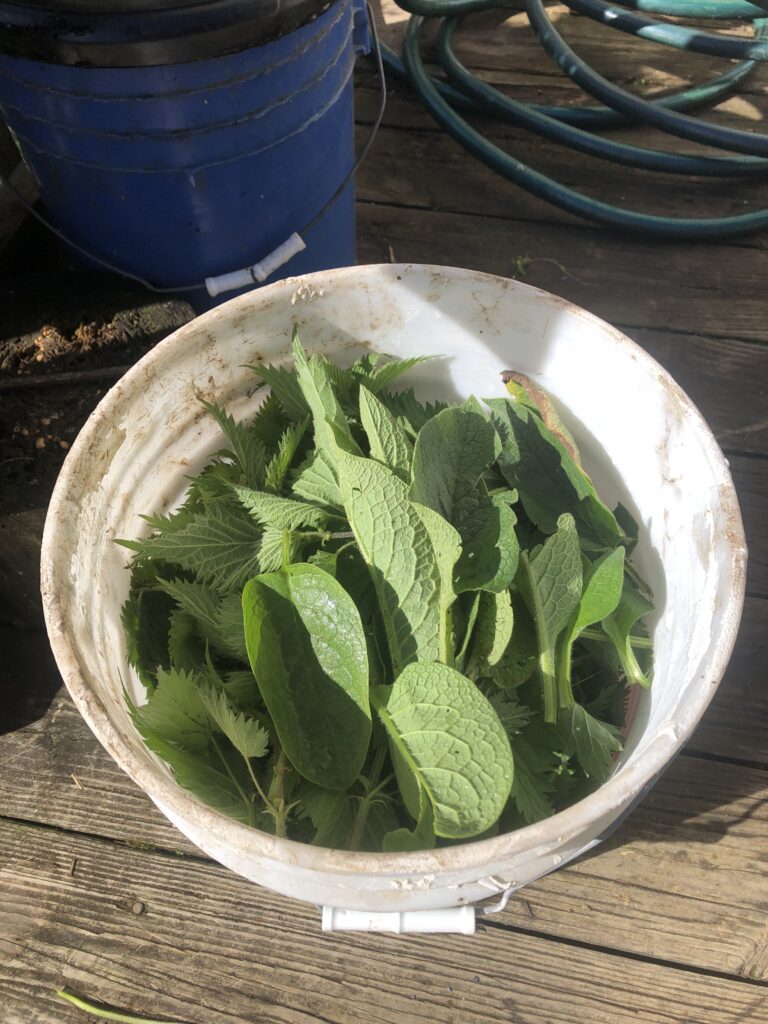
We’ve come to associate spraying with noxious pesticides that kill beneficial insects and harm our health and soils, but there are other kinds of sprays that can boost phytochemistry by providing positive, biological reinforcement. Much like the probiotic approach to human health, these sprays are proactive. They reinforce plant immunity instead of waiting for big problems to arise that require brutal tactics to defeat. The conventional, allopathic approach has focused on killing diseases, but the holistic orchardist endeavors to feed the arboreal food web with all the living organisms and nutrients the orchard needs to defend itself.
Make sense?
If you got into building food forests because you thought it would be less labor intensive, or if you thought that once your trees were established you could kick back in your hammock and dangle grapes into your mouth, then Micheal Phillips’ spray regime (may he rest in peace), will fill you with dismay. Phillips basically has you out in the orchard spraying every 7-10 days from bud break to first freeze. If you want good lookin’ pome and stone fruit, there’s basically no way of avoiding the spray tank. You can either go holistic, or you can go allopathic. Proactive nutrient rich sprays are made predominantly from plants and are a superior approach to using mineral fungicides (copper, sulfur, lime sulfur) which can have negative impacts on the soil as well as beneficial insects and microorganisms.
The kind of spray I’m going to focus on here is used primarily in the summer months, right after Phillips core holistic spring sprays are done and the fruitlets are starting to reveal themselves. These herbal teas can be applied every 7-10 days through to the final fall clean up.
The following instructions are for a 4-gallon backpack sprayer. If you want the original recipe, made for a much larger dose, you can go here.
Time to get your zymurgy on. There are two kinds of herbal tea sprays: the calcium brew and the silica brew. (Note: both of these are anaerobic brews and will stink to high heaven, but don’t let that stop you!)
Calcium:
- Fill a 5 gallon bucket with comfrey and green nettle (both easy plants to grow)
- Throw in a few garlic scapes if they’re in season
- Pour a kettle of boiling water over the herbs
- Add 2 cups of activated EM-1
- Add milk, 5 cups, preferably raw
- Add 0.36lbs (1/3 cup) of gypsum (calcium sulfate)
- Top up the bucket with UNCHLORINATED water
- Epsom salts can be added for trees needing magnesium
- Stir every other day for 10-14 days to allow fermentation
- Remove the plant debris using a garden fork
- Add 0.01lb (about 1TBL) of soluble humic/fulvic acids. Not optional!
- Your herbal tea is now ready for use. Put it through a strainer before adding it to the tank.
Silica:
- Fill a 5 gallon bucket with horsetail and seeded nettle
- Throw in a few garlic scapes if they’re in season
- Pour a kettle of boiling water over the herbs
- Add 2 cups of activated EM-1
- Add 0.18lbs of Azomite clay and/or soft rock phosphate
- Add 0.18lbs of Granite meal and/or basalt dust
- Top up the bucket with UNCHLORINATED water
- Epsom salts can be added for trees needing magnesium
- Stir every other day for 10-14 days to allow fermentation
- Remove the plant debris using a garden fork
- Add 0.01lb of soluble humic/fulvic acids. Not optional!
- Your herbal tea is now ready for use. Put it through a strainer before adding it to the tank.
Add a quart of both of these recipes to your 4 gallon backpack sprayer along with an adapted version of the core holistic spray:
Adapted Holistic Spray:
- 6 oz Karanja Oil, emulsified with a small spoonful of biodegradable soap
- 5 TBLs liquid kelp
You will have left over calcium and silica brew. The effective microbes within it are ideally used within thirty-five days, but can be used for up to sixty-five days.
After you’ve added calcium, silica, and holistic ingredients. fill the reminder of your tank with warm water and then get out there. Feed the whole arboreal being: leaf, trunk, and soil. Feel accomplished.
MORE INFO:
The Holistic Orchard by Michael Phillips
Fermented Plant Extracts from the Holistic Orchard Network
Orcharding 101 with Michael Phillips, start at minute 41:00
This POP Blog was written by Lead Orchard Volunteer Anisa George.
SUPPORT US! If you found this entry useful, informative, or inspiring, please consider a donation of any size to help POP in planting and supporting community orchards in Philadelphia: phillyorchards.org/donate